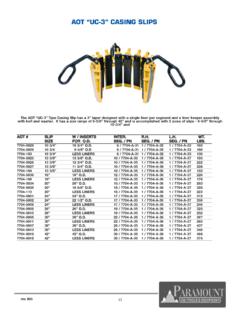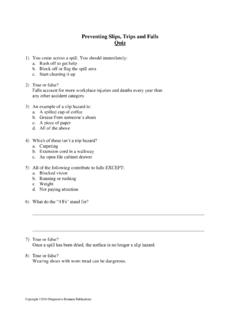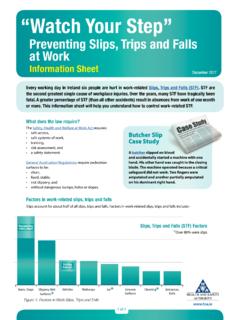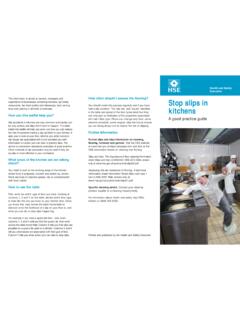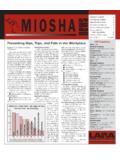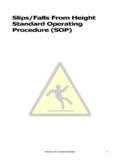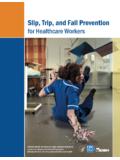Transcription of Topic Inspection Pack - Slips & Trips
1 Slips and Trips Topic Inspection pack Topic Inspection pack Slips AND Trips APRIL 2011 Page 1 of 53 Slips and Trips Topic Inspection pack CONTENTS Equality impact assessments 1. MANAGEMENT OF Slips AND Trips Importance of effective management arrangements Risk profiling The business case for preventing Slips and Trips Core principles of managing for health and safety using Slips and Trips as a risk control system Leadership, management, competence and worker involvement Assessing leadership Assessing management Assessing competence Assessing worker involvement 2. GATHERING THE EVIDENCE Observations and tools Use of the Slips assessment tool Sources of advice and technical support for inspectors 3. PRACTICAL RISK CONTROL MEASURES FOR Slips AND Trips Generic control measures Sector-specific control measures Sector-specific case studies in health and education Table 1 Generic control measures for preventing Slips and Trips 4.
2 LEGAL REQUIREMENTS General Specific legal requirements Table 2 Summary of legal requirements on Slips and Trips 5. ENFORCEMENT OF Slips AND Trips - OVERVIEW 6. ENFORCEMENT Immediate action Establishing the initial enforcement expectation (IEE) Table 3 Determining the risk gap for Slips and Trips Table 4 Establishing the risk gap for significant slip and Trips hazards Outputs factors varying the initial enforcement expectation 7. TEMPLATES FOR IMPROVEMENT NOTICES Table 5 Templates for Improvement Notices 8. REFERENCES TO GUIDANCE AND INFORMATION SOURCES Appendix 1 - Inspection checklist for the effective management of Slips and Trips Appendix 2 Managing Slips in health services enforcement case study Page 2 of 53 Slips and Trips Topic Inspection pack Equality Impact Assessments Inspectors should be aware of who, in terms of diversity, are the target group in the sector they are dealing with. It is not about treating everyone the same but about addressing individual requirements in relation to Gender, Age, Disability, Race, Relig-ion and Belief, Sexual orientation and Transgender.
3 Inspectors should give consideration to and factor into their approach any issues that may surround their audience, such as literacy, English as a second language and disability (access needs). Public bodies are legally required to eliminate unlawful discrimination and to promote equality of opportunity when organising campaigns, work programmes and policy proposals or reviews. HSE must ensure the services we provide are accessible and meet the needs of those we serve and the Equality Impact Assessment Toolkit is a way of accessing how a policy/guidance/webpage/regulation affects individuals. An Equality Impact Assessment (EIA) looks at the actual, potential or likely impact of a service, policy, project or significant change on different groups of people. It is also important to include gender issues in workplace risk assessments, and mainstreaming gender issues into risk prevention is now an objective of the European Community.
4 For further information, please see: http://intranet/diversity/impact Or email the Diversity Team. Page 3 of 53 Slips and Trips Topic Inspection pack 1. MANAGEMENT OF Slips AND Trips Importance of effective management arrangements To apply this Topic pack , inspectors should be familiar with Managing for health and safety - Guidance for regulatory staff on the practice of assessing health and safety management. To reduce Slips and Trips risks, it is crucial that employers have effective management ar-rangements, with strong leadership, competent managers and staff and genuine worker in-volvement. The degree of formality of these arrangements should be proportionate to the size and nature of the undertaking. Well-managed companies will identify precisely the causes of Slips and Trips accidents and then select, implement and maintain the control measures which are appropriate.
5 Deficiencies highlighted in the risk assessment should be addressed through a management action plan. Getting workforce buy-in to initiatives to re-duce Slips and Trips is crucial to their success. To make lasting reductions in the prevalence of Slips and Trips , attitudes and perceptions must change and both duty holders and employees have to understand the causes and conse-quences of slip and trip accidents. Sensible measures should be taken to control and mini-mise risk, but personal responsibility and worker participation are also essential if these measures are to be effective. Risk profiling Slips and Trips hazards are present in most workplaces, and in some sectors they will repre-sent one of the main safety issues in a company s risk profile. Assessing how such compa-nies manage Slips and Trips risks will be a good indicator of how they manage health and safety in general.
6 Slips and Trips can therefore often be used as a good risk control system to help evaluate health and safety management systems. There is more information about risk profiling on HSE s web pages: The business case for preventing Slips and Trips Many employers do not give Slips and Trips the priority they deserve. They treat them as being outside their control, inevitable or simply the employee s fault. Employers can, and should, create a work environment and culture where Slips & Trips are much less likely to happen. Often the measures needed are simple and low-cost, but they will bring about significant reductions both in human suffering and costs. Slipping and tripping are not inevitable, unless, of course, hazards are allowed to remain un-controlled. Effective action can be taken to dramatically reduce slipping and tripping acci-dents. Such action is not only a legal requirement and morally right, it also makes good busi-ness sense.
7 Slipping and tripping are the most common causes of major injuries within UK workplaces. Each year about 11,000 major injuries are caused by slipping and tripping (in 2009/10 Slips and Trips caused 41% of all occupational major injury accidents). Around 90% of these acci-dents involve broken bones and 42% of work related fracture injuries result in absences from work of between 1 - 3 months. About 40% of reported injuries to members of the public are Slips and Trips . In addition, Slips and Trips are often the initiators of accidents attributed to other causes, such as some machinery accidents, scaldings and probably over one third of falls from height. Occupational accidents formally classified as Slips and Trips cost the UK economy about 800 million each year and employers over 500 million. They cost the NHS about 115 million. Some successful organisations have long recognised that good management of slipping and tripping risks is an integral part of good overall business management.
8 Page 4 of 53 Slips and Trips Topic Inspection pack Core principles of managing for health and safety - Using Slips and Trips as a risk control system A safety management system is likely to be based on an approach of plan, do, check and act/review: PlanDevelop policyAssess risksRisk profileprioritisingSet targetsActImprovereview on lessons learntFollow up on actionsCheckAssess performanceMonitor before eventsInvestigate post eventsDoImplement precautionsControl activitiesMotivate peopleLeadership;Workers involved &competent Plan Consideration, selection and development of health and safety practices and procedures, risk profiling/assessment, strategies/plans, benchmarking, performance measures Do Implementation of practices and procedures and on-the-ground management of health and safety, leadership, management, competence, training, worker involve-ment, incentives/rewards Check Monitor and review health and safety performance and activity, accident in-vestigation, improvement, measuring costs/benefits Act/review Based on monitoring and review, address any problem areas, audit, re-view To help inspectors to formulate questions on the management of Slips and Trips , an Inspection checklist for the management of Slips and Trips is provided in appendix 1.
9 This gives examples of good features of the management of Slips and Trips under each of the headings: plan/ do/ check/ act/ review. Inspectors can then use the findings from this line of questioning as indica-tors of the effectiveness of a company s safety management system. The following section complements this approach by focusing particularly on the HSE Strat-egy themes of leadership, competence, management arrangements and workforce involve-ment, giving examples of how these themes can be explored to determine how successfully a company is managing Slips and Trips . Leadership, competence, management arrangements and workforce involvement Managing for health and safety includes questions to raise at inspections on the HSE strategy themes of: Strong leadership Management arrangements Competence Workforce involvement Page 5 of 53 Slips and Trips Topic Inspection pack This Topic pack continues to focus on each of these themes in the context of Slips and Trips .
10 It provides practical questions for inspectors to ask on Slips and Trips issues, using the Topic as an indicator to help assess the effectiveness of safety management systems. These ques-tions are additional to the common ones provided in Managing for health and safety. They are supported by examples of what it looks like when done well and what it looks like when it is done badly or not at all . Page 6 of 53 Slips and Trips Topic Inspection pack Assessing leadership LEADERSHIP QUESTIONS TO ASK (in making your initial assessment and gauge their genuine commitment to H&S) What are your top residual/actual risks/areas, which need more/better control? Where do Slips / Trips lie in this ranking? Can you provide evidence that management reviews accident data, acts on it and shares information with staff to improve the H&S culture? What plans do you have to reduce Slips and Trips ? What are the obstacles to achieving them, and how do you plan to overcome them?










